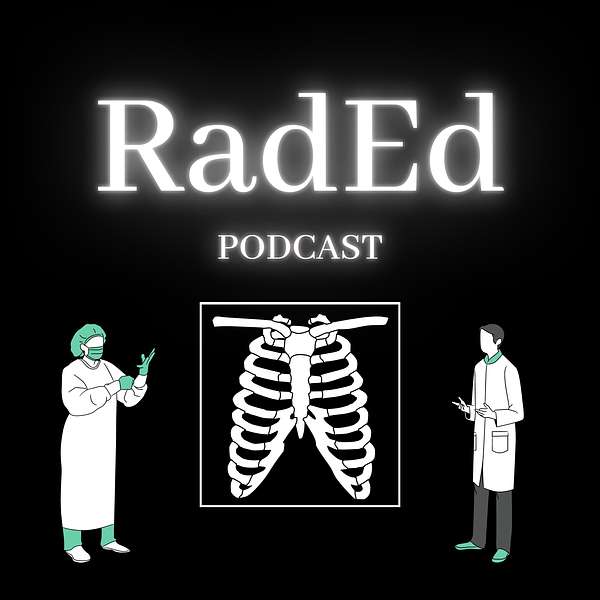
RadEd
This is a podcast about all things radiology designed for medical students, residents, attending radiologists, and anyone else interested! The goal of this podcast is to educate people on and explore the field of radiology. Topics covered include: diagnostic imaging modalities, important radiology concepts/findings, current research topics in the field, technologies and procedures of the field, social and ethical challenges, radiology as a career, interviews with radiologists, and much more!
RadEd
Chest X-Ray: Basics
- Indications: broad (respiratory or cardiac disease, tube positioning, trauma)
- Characteristics of a good chest x-ray (PIER):
- Projection (AP, PA, lateral, lateral decubitus): heart will appear bigger on AP, but not by much, AP is better for intubated/sick patients, two views is KEY
- Inspiration and ribs: do you see at least 8-9 posterior ribs (if too little inspiration, things can crowd and mimic abnormalities)
- Exposure: can you see the spine through the heart (too much penetration makes things dark, too little makes things bright and fuzzy)
- Rotation and clavicles: what is the relationship between the clavicles and thoracic spinous processes (patient rotated to their right will have their left clavicle appear closer to the spinous process)
- Angle of patient: should be perpendicular, but x-ray beams may be angled upward (apical lordotic), which can make anterior structures look more superior (clavicles above first rib)
- Approach
- Start every time with verifying patient information and imaging quality (PIER)/information
- Then execute your systematic approach for consistency
- Common approach is the tubes + ABCDEFGHI approach
- First looks at tubes, lines, drains
- A = airway, B= bones, C = cardiac, D = diaphragm, E = effusions/extra-thoracic tissues, F = fields, fissures, foreign bodies, G = great vessels, gastric bubble, H = hilum and mediastinum, I = impression
- A/airway = follow the trachea down, is it midline
- B/bones = follow outline of bones to look for fractures
- C/cardiac = heart should be around or less than 50% diameter of chest
- D/diaphragm = right hemi is slightly higher due to liver, are they flattened
- E/effusions and extra-thoracic tissues = check costophrenic angles, lateral films, look for swelling, subcutaneous air
- F/fields, fissures, and foreign bodies = check lung fields for opacities, masses, pneumothorax, vessel markings, look at major and minor fissures, assess any foreign bodies (wires)
- G/great vessels and gastric bubble = follow path of aorta, pulmonary arteries and veins, gastric bubble under left hemidiaphragm
- H/hilum and mediastinum = look for prominence (sarcoid), lymphadenopathy, masses, check for mediastinal widening (thymus can be normal in kids)
- I/impression = overall conclusion or what is going on considering your findings
References: Herring's Learning Radiology, Radiopaedia, Mandell's CORE Radiology